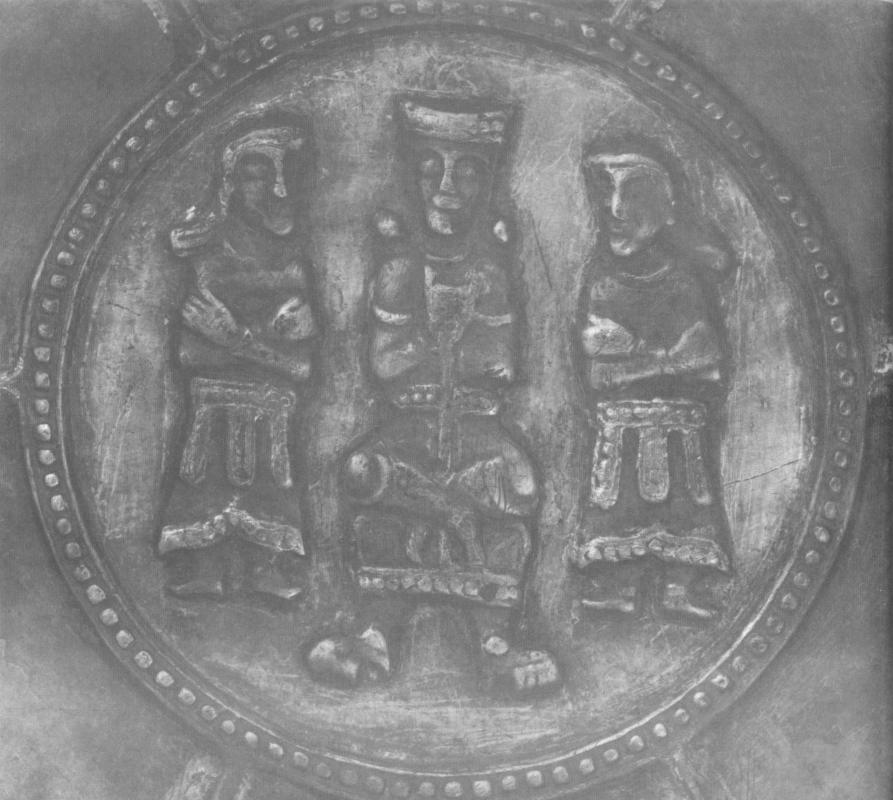Ladle with the image of the ruler on the throne and two courtiers, 11th century.
Found at Muzhi, Russia.
34. Ladle with the image of the ruler on the throne and two courtiers.
Silver, gilding. The largest size is 16.5; height 3.5. Localization is difficult, XI century.
An accidental find at a Khanty sanctuary near Lake Shuryshkarsky Sor (Shuryshkarsky district of the Yamalo-Nenets Autonomous National District).
Museum of village local lore. Muzhi; inv. No. OF-801.
A six-segmented ladle with a horizontal handle in the form of a three-part arch with a thickened rim.
The ladle is deformed, cracked, part of the body and handle are missing.
The bottom medallion (6.6 cm in diameter) is framed by a flat embossed rim in the form of a narrow ribbon - up to 0.3 cm - with embossed "pearl" circles.
The space of the medallion is filled with three figures. In the centre is the ruler on the throne; he sits "in an oriental way" (legs tucked), leaning on a sword.
The toes of his knee-high boots dangle from the seat cushion and touch the bottom edge of the throne.
The edge of the seat is marked with a horizontal stripe decorated with circles; the zoomorphic legs of the throne are emphatically massive.
The face is beardless, Caucasian, with a narrow protruding chin giving it a triangular shape.
Long nose, small mouth with wide lips leave no room for a mustache; tufts of hair above the shoulders are rendered in a smooth relief.
The headpiece in the form of a low crown is decorated with a row of circles; on the neck - a band;
details of the caftan are not visible except for the transverse tiraz stripes (?) above the elbow fold.
A narrow belt decorated with a row of "pearls" is clearly visible. The hands are hard to see.
The figures of the courtiers are of equal size; both stand in respectful postures, arms folded across their chests.
The hands, covered with narrow caftan sleeves, are accentuated.
Both have simple hair; a three-quarter turn of the heads (with a strictly frontal setting of the body) shows that their attention is directed to the central character;
the modeling of beardless faces reveals slight cheekbones.
Hair is long, lying on the shoulders, they are gathered in a bun (or braid).
There is a band on the neck.
Caftan with a characteristic figured cut; the lower edge is marked with a wide strip "with pearls", both are belted with belts similar to the belt of a ruler,
but each such belt has three additional hanging straps.
The feet of the figures are turned in different directions.
In height, the figures of the courtiers are at their full height equal to the seated ruler, but the top of their heads reaches only the lower edge of their master's crown.
All three figures are connected compositionally, not plastically.
They seem to hang against a smooth background, the gilding of which enhances the outline of the images made in low relief,
which makes the figures themselves acquire the character of emphasized isolation.
Some details of the costume are highlighted with gilding - a belt, patterned edges of caftans, details of a throne. ...
The vessel was initially made as a casting into a shape close to the final one, and then engraved.
...
The iconography of the medallion of our vessel is based on a Sassanian subject of the 6th-7th centuries:
frontally, resting his hands on a sword, the Iranian king sits surrounded by four nobles on a platter from the Hermitage collection (Trever, Lukonin, 1987, p. 109, no. 8).
The number of figures surrounding the central character, in our case, is reduced to two, as on the Iranian silver bowl of the 11th century, from the village of Melken (Smirnov, 1909, ill. 141)
with a scene of an imperial feast (Marshak, 1976: 161, 162; Marschak, 1986, S. 108;
Darkevich mistakenly dates the bowl from the 2nd half of XII to the first half XIII century:
Darkevich, 1976, pp. 14, 15, 114) or the Gaznavid bronze bowl from the Metropolitan Museum
(Ettinghausen, 1955, pp. 107-131).
The subject images on Buyid medals can also be attributed to the circle of analogies (Trever, p. 260; Kühnel, 1956).
The reworking of the Ghaznavid plot can be seen in the decoration of the famous bronze bowl from the collection of the British Museum,
known as the Vaso Vescovali (Khorasan, early 13th century):
here the courtiers sit on both sides of the throne in one of eight medallions (Ward, 1993, p. 20, Fig. 10; p. 79, Fig. 57).
Judging by the central medallion of a bronze dish found near Hamadan,
this subject in the toreutics of Western Iran (?) survives until the 70s, XIII century (Ward, 1993, p. 87, Fig. 66).
In the XIII century, it is also found in the metal of Mesopotamia and Syria.
Source: Plate 34, "Treasures of the Ob Basin." Formika. 1996.228
See also Horseman on silver dishes from "Magna Hungaria" (Ural region)
See also Plates with figures from Persia and Central Asia
Other 11th Century Illustrations of Costume & Soldiers

